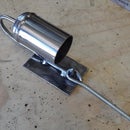Introduction: Sailmaker's Whipping - Step by Step
Whippings are put on the end of a rope to prevent the rope from unlaying. Whippings are most necessary for natural fibre ropes that can't be melted.
Whippings are preferable to back-splices whenever there is a need for the rope's end to pass through an eye or a block. I think a whipping is always preferable because a back-splice will catch on anything at the most inconvenient moment.
Whippings are usually made from waxed twine or rope yarn. For my example I've used some braided cord. A boot lace will do.
The length of a whipping should be at least equal to the diameter of the rope, and for permanent whippings, a second one should be made nine diameters from the end.
My favourite whipping is the sailmaker's whipping. I think it looks great and I've never seen one work adrift. Here's how to make one...
Whippings are preferable to back-splices whenever there is a need for the rope's end to pass through an eye or a block. I think a whipping is always preferable because a back-splice will catch on anything at the most inconvenient moment.
Whippings are usually made from waxed twine or rope yarn. For my example I've used some braided cord. A boot lace will do.
The length of a whipping should be at least equal to the diameter of the rope, and for permanent whippings, a second one should be made nine diameters from the end.
My favourite whipping is the sailmaker's whipping. I think it looks great and I've never seen one work adrift. Here's how to make one...
Step 1: Getting Started
- Get the end of the rope to be whipped in one hand.
- Get the twine in your other hand.
- Poke the end of the twine through the rope passing under one of the strands. About 200mm from the end of the rope.
- Now pass the twine over the next rope strand and then through the rope again going under the last strand. It should come out between the same two strands you first poked it through.
- Pull the twine through to give yourself about 200mm hanging out.
- Leave about 50mm of bight hanging at the back.
- You should now be ready to start whipping.
Step 2: Whip It!
- Leave the short end of twine and the bight hanging.
- Take the long part of twine and tightly pass it round and round the rope, working against the lay, toward the end of the rope.
- Continue until you have sufficient turns. The whipping should be at least as long as the rope is wide.
Step 3: Make It Stay Whipped
- Now take the bight of twine and pass it up the outside of the whipping, following the lay of the strand that it surrounds (I hope that makes sense - comment if you want clarification), and then hook it over the end of the strand at the end of the rope.
- Grab hold of the short end of the twine and pull hard. This will tighten the bight. As you pull work the bight neatly down between the strand at the rope's end.
- When the bight is nice and tight bring the short end of twine up outside the whipping, again following the lay of the rope.
- Reef know the two ends of twine at the centre of the rope.
Step 4: Finishing
- Trim the twine leaving just enough length so you can be confident the reef knot won't work loose.
- Trim the rope leaving just enough length to hide the reef knot in the twine.
- The whipping may be dressed with varnish - though I never have found this necessary.
I hope you have enjoyed this Instructable, and I really hope it might be of use to someone.
Please feel free to comment or ask questions.






